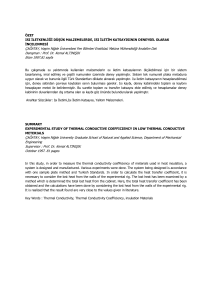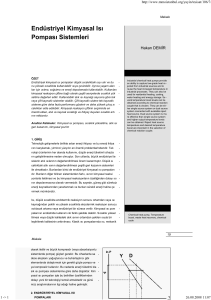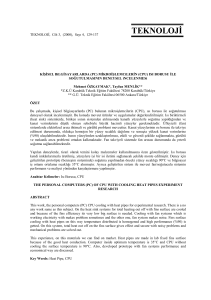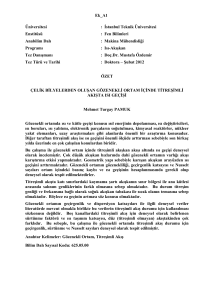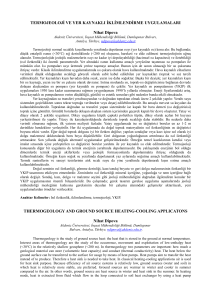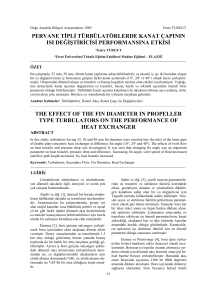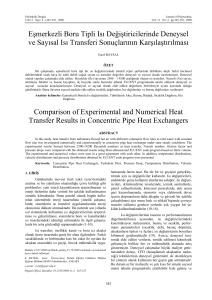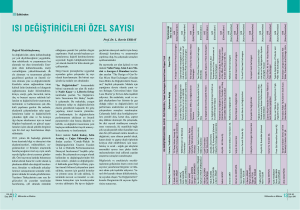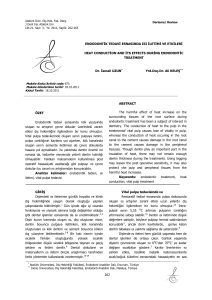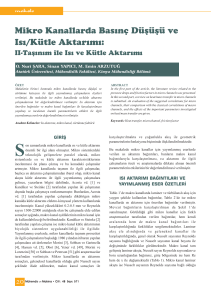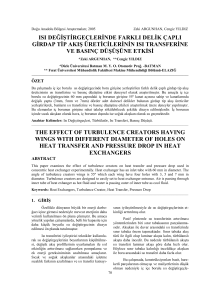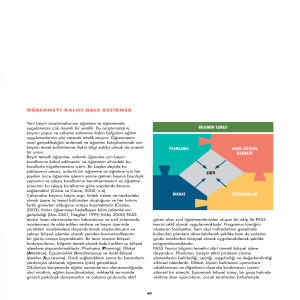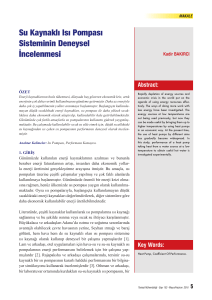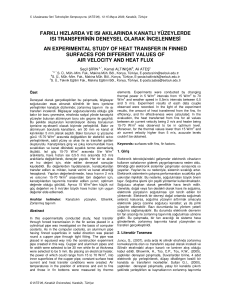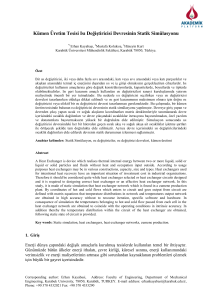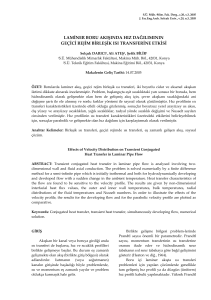the effects of condenser performance on the refrıgeratıon system of
advertisement
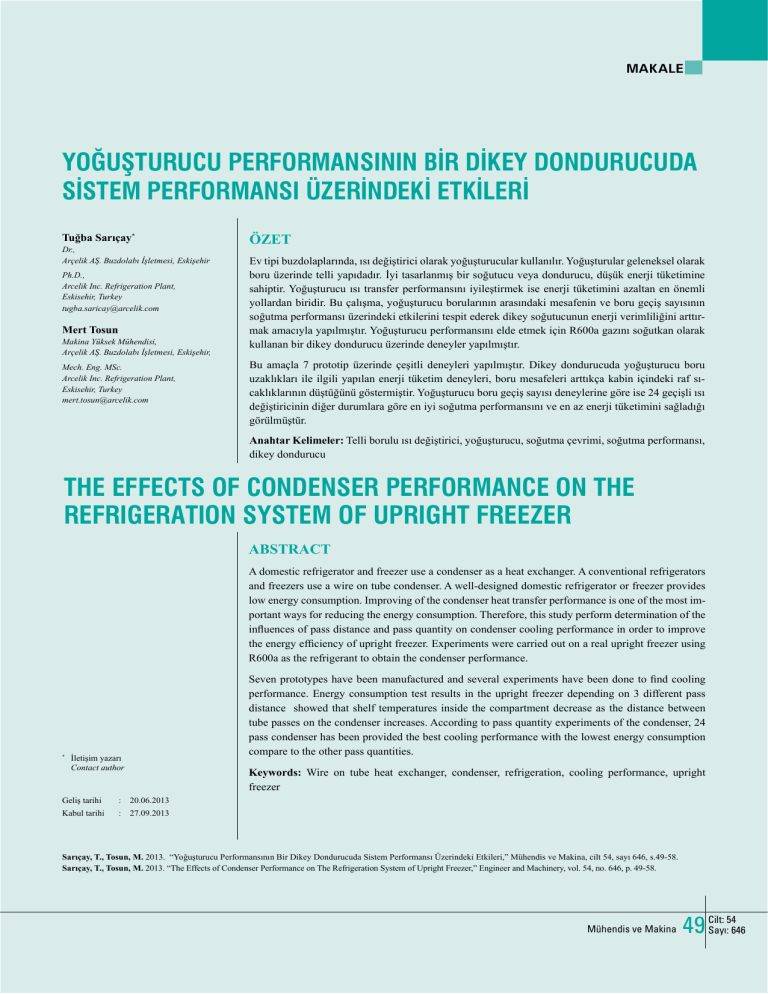
MAKALE YOĞUŞTURUCU PERFORMANSININ BİR DİKEY DONDURUCUDA SİSTEM PERFORMANSI ÜZERİNDEKİ ETKİLERİ Tuğba Sarıçay* Dr., Arçelik AŞ. Buzdolabı İşletmesi, Eskişehir Ph.D., Arcelik Inc. Refrigeration Plant, Eskisehir, Turkey [email protected] Mert Tosun Makina Yüksek Mühendisi, Arçelik AŞ. Buzdolabı İşletmesi, Eskişehir, Mech. Eng. MSc. Arcelik Inc. Refrigeration Plant, Eskisehir, Turkey [email protected] ÖZET Ev tipi buzdolaplarında, ısı değiştirici olarak yoğuşturucular kullanılır. Yoğuşturular geleneksel olarak boru üzerinde telli yapıdadır. İyi tasarlanmış bir soğutucu veya dondurucu, düşük enerji tüketimine sahiptir. Yoğuşturucu ısı transfer performansını iyileştirmek ise enerji tüketimini azaltan en önemli yollardan biridir. Bu çalışma, yoğuşturucu borularının arasındaki mesafenin ve boru geçiş sayısının soğutma performansı üzerindeki etkilerini tespit ederek dikey soğutucunun enerji verimliliğini arttırmak amacıyla yapılmıştır. Yoğuşturucu performansını elde etmek için R600a gazını soğutkan olarak kullanan bir dikey dondurucu üzerinde deneyler yapılmıştır. Bu amaçla 7 prototip üzerinde çeşitli deneyleri yapılmıştır. Dikey dondurucuda yoğuşturucu boru uzaklıkları ile ilgili yapılan enerji tüketim deneyleri, boru mesafeleri arttıkça kabin içindeki raf sıcaklıklarının düştüğünü göstermiştir. Yoğuşturucu boru geçiş sayısı deneylerine göre ise 24 geçişli ısı değiştiricinin diğer durumlara göre en iyi soğutma performansını ve en az enerji tüketimini sağladığı görülmüştür. Anahtar Kelimeler: Telli borulu ısı değiştirici, yoğuşturucu, soğutma çevrimi, soğutma performansı, dikey dondurucu THE EFFECTS OF CONDENSER PERFORMANCE ON THE REFRIGERATION SYSTEM OF UPRIGHT FREEZER ABSTRACT A domestic refrigerator and freezer use a condenser as a heat exchanger. A conventional refrigerators and freezers use a wire on tube condenser. A well-designed domestic refrigerator or freezer provides low energy consumption. Improving of the condenser heat transfer performance is one of the most important ways for reducing the energy consumption. Therefore, this study perform determination of the influences of pass distance and pass quantity on condenser cooling performance in order to improve the energy efficiency of upright freezer. Experiments were carried out on a real upright freezer using R600a as the refrigerant to obtain the condenser performance. İletişim yazarı Contact author * Geliş tarihi : 20.06.2013 Kabul tarihi : 27.09.2013 Seven prototypes have been manufactured and several experiments have been done to find cooling performance. Energy consumption test results in the upright freezer depending on 3 different pass distance showed that shelf temperatures inside the compartment decrease as the distance between tube passes on the condenser increases. According to pass quantity experiments of the condenser, 24 pass condenser has been provided the best cooling performance with the lowest energy consumption compare to the other pass quantities. Keywords: Wire on tube heat exchanger, condenser, refrigeration, cooling performance, upright freezer Sarıçay, T., Tosun, M. 2013. “Yoğuşturucu Performansının Bir Dikey Dondurucuda Sistem Performansı Üzerindeki Etkileri,” Mühendis ve Makina, cilt 54, sayı 646, s.49-58. Sarıçay, T., Tosun, M. 2013. “The Effects of Condenser Performance on The Refrigeration System of Upright Freezer,” Engineer and Machinery, vol. 54, no. 646, p. 49-58. Mühendis ve Makina 54 49 Cilt: Sayı: 646 Yoğuşturucu Performansının Bir Dikey Dondurucuda Sistem Performansı Üzerindeki Etkileri The Effects of Condenser Performance on the Refrigeration System of Upright Freezer B 1. GİRİŞ ir ısı eşanjörü; dışarısıyla ısı veya iş etkileşimi olmadan iki veya daha fazla sıvı arasında, bir katı yüzey ve sıvı arasında ya da katı parçacıklar ve sıvı arasında dahili termal enerji (entalpi) aktarımını sağlayabilen bir araçtır. Akışkanlar, tek bileşenli veya karışım olabilir. Tipik uygulamalar arasında akışkanların ısıtılması ve soğutulması, tek veya çok bileşenli akışkanların buharlaştırılması veya yoğuşturulması, bir sisteme ısı verilmesi veya sistemden ısı çekilmesi gösterilebilir. Diğer uygulamalarda, sterilizasyon, pastörizasyon, distilasyon, yoğunlaşma, kristalleştirme veya işlenen akışkanı kontrol etmek amacıyla da kullanılabilir. Bazı ısı değiştiricilerde ısı transferi olan akışkanlar doğrudan temas etmektedir. Diğer bazılarında ise ısı transferi, akışkanları ayıran bir duvar aracılığıyla duvarın üzerinden içeri veya dışarı süreksiz olarak gerçekleşir. Birçoğunda, akışkanlar bir duvar ile ayrılır ve karışmazlar [1]. Isı transfer yüzeyi; akışkanların doğrudan temas halinde olduğu, ısının üzerinden iletimle aktığı yüzeylere denir. Yüzeyin akışkanları ayıran kısmı birincil veya doğrudan yüzey olarak adlandırılır. Isı transfer yüzeyini arttırmak için kanat olarak bilinen uzantılar, birincil, ikincil veya dolaylı yüzeylere bağlanabilir. Bu kanatların eklenmesiyle o yüzeydeki ısıl direnç azalır ve aynı sıcaklık farkındaki net ısı transfer miktarı artar [1]. Isı değiştiriciler, farklı bir ortamı kullanan çok amaçlı ana bir enerji kaynağı olduğunda veya sıcaklığın ve basıncın tasarım limitlerinde olmadığı durumlarda kullanılır. Isı değiştiriciler [2]: • Merkezi su sistemlerinde kazandaki buharı yoğuşturarak sıcak su elde etmek için, • Tanklı veya tanksız sıcak su ve buhar kazanlarında içilebilir veya içilemez su hizmeti vermek için, • Soğutma kulelerinde ve yalıtılmış termal ünitelerde donmaya karşı koruma gibi sistemlerin belirli kısımlarında istenilen sıcaklıkların elde edilmesinde, • İki farklı basınçta çalışan akışkanlar arasındaki ısı transferi gerçekleşirken sistemlerin yalıtılması için, • Yoğuşturmalı soğutma, hava üflemeli soğutma, körüklü kazan, ısıl depolama ve serin saklama (serbest soğutma) gibi uygulamalarda enerji tasarrufu amacıyla, • Buharlaştırıcı, yoğuşturucu ve sıvı soğutucu gibi buzdolabı uygulamalarında kullanılabilir. Makalenin İngilizcesi yazarları tarafından sağlanmıştır. * Cilt: 54 Sayı: 646 50 Mühendis ve Makina Tuğba Sarıçay, Mert Tosun 1. INTRODUCTION* 2. TELLİ BORULU ISI DEĞİŞTİRİCİLER 2. WIRE ON TUBE HEAT EXCHANGERS heat exchanger is a device to provide for transfer of internal thermal energy (enthalpy) between two or more fluids, between a solid surface and a fluid, or between solid particulates and a fluid, in thermal contact without external heat and work interactions. The fluids may be single compounds or mixtures. Typical applications involve heating or cooling of a fluid stream of concern, evaporation or condensation of single or multicomponent fluid stream, and heat recovery or heat rejection from a system. In other applications, the objective may be to sterilize, pasteurize, fractionate, distill, concentrate, crystallize, or control process fluid. In some heat exchangers, the fluids transferring heat are in direct contact. In other heat exchangers, heat transfer between fluids takes place through a separating wall or into and out of a wall in a transient manner. In most heat exchangers, the fluids are separated by a heat transfer surface and do not mix [1]. Telli borulu ısı değiştiriciler, küçük soğutma sistemlerinde yıllardır en çok kullanılan ısı değiştiricilerdir. Boru yığınından oluşan bu değiştiricilerde boruların içinden soğutkan gibi bir ısı taşıyıcı akışkan akarken, hava gibi ikinci bir akışkan da boruların üzerine yönlendirilir. Bu tip ısı değiştiricilerde hava tarafı ısıl direnci, soğutkan tarafına göre çok daha yüksek olduğu için hava tarafına örneğin Şekil 1’de gösterildiği gibi boru dizisi üzerine teller kaynatılarak büyütülmüş yüzeyler oluşturulur ve diğer borulu ısı değiştiricilerde olduğu gibi verimli bir şekilde direnç düşürülür [3]. Wire on tube type heat exchanges which has probably been the most widely used in small refrigerant systems for many years consist of tube bundles in which a heat transfer medium such as refrigerant is forced to flow, while a second heat transfer fluid like air is directed across the tubes. Since the airside thermal resistance of this heat exchanger is much higher than that of refrigerant side, enhanced surfaces such as wires straightly welded on the series of tubes are employed to effectively reduce the resistance as in the other wire on tube heat exchangers, as shown in Fig. 1. [3] Telli borulu ısı değiştiricilerde, dairesel ve dörtgen kesitli borular yaygın olarak kullanılırken eliptik kesit de bulunabilir. Kanatlar (teller) genel olarak boruların dış tarafında bulunur; ancak bazı uygulamalarda boruların içinde de görülebilir. Kanatlar, borulara mekanik kenetleme, gererek sarma, yapıştırma, lehimleme, aşındırma, kaynak, çekme gibi yöntemlerle bağlanır [1]. In wire on tube type of exchanger, round and rectangular tubes are the most common, although elliptical tubes are also used. Fins (wires) are generally used on the outside, but they may be used on the inside of the tubes in some applications. They are attached to the tubes by a tight mechanical fit, tension winding, adhesive bonding, soldering, brazing, welding, or extrusion. [1] Bu ısı değiştiricilerin boruları, yatay veya dikey konumlandı- These heat exchangers may be assembled with tubes in a verti- A The heat transfer surface is a surface of the exchanger core which is in direct contact with fluids and through which heat is transferred by conduction in a recuperator. The portion of the surface which also separates the fluids is referred to as a primary or direct surface. To increase heat transfer area, appendages known as fins may be intimately connected to the primary surface to provide an extended, secondary, or indirect surface. Thus, the addition of fins reduces the thermal resistance on that side and thereby increases the net heat transfer from the surface for the same temperature difference [1]. Heat exchangers are used when the primary energy source is available for multiple purposes, uses a different medium, or its temperature or pressure is not in the design limits. Heat exchangers are used [2]: • To condense the steam from a boiler to produce hot water for central water systems • For service water for potable and non-potable applications, which is often heated by a converter and hot water or steam boilers, with or without a storage tank (a) (b) • To meet special temperature requirement of portions of a system or to protect against freezing in isolated terminal units (coils) and cooling tower basins • To isolate two systems operating at different pressures while transferring thermal energy between them • In energy saving applications such as condensate cooling, vent condensing, boiler blow down, thermal storage, and chiller bypass (free cooling) • In many refrigeration applications as evaporators, condensers, and liquid coolers (c) (d) Şekil 1. Telli borulu ısı değiştirici tipleri (a) Sargı tipi (dörtgen) (b) Sargı tipi (sarmal) (c) Raf Tipi d) Arka duvar tipi Figure 1. Types of wire on tube heat exchangers (a) Coil type (rectangular) (b) Coil type (helical) (c) Shelf type (d) Back Wall type Mühendis ve Makina 54 51 Cilt: Sayı: 646 Yoğuşturucu Performansının Bir Dikey Dondurucuda Sistem Performansı Üzerindeki Etkileri The Effects of Condenser Performance on the Refrigeration System of Upright Freezer rılabilir. Hava hareketi de doğal veya zorlanmış olabilir. Telli borulu ısı değiştiriciler, göreceli olarak daha ucuz oldukları için adetleri yüz milyonları bulan ve her yıl milyonlarcası daha markete giren, kayda değer bir enerji tüketen ev tipi soğutucu dondurucu buzdolaplarında yaygın olarak kullanılmaktadırlar [4]. cal or horizontal position and the air movement can be forced or natural. Since wire-and-tube condensers are relatively inexpensive, they have been widely applied in household refrigerators and freezers – appliances that consume a considerable amount of energy since hundreds of millions are currently in use, and dozens of millions are coming onto the market every year. [4] Çeşitli telli borulu ısı değiştiricilerin ısıl performanslarının incelendiği birçok çalışma bulunmaktadır. There are many research works reporting thermal performances of various kinds of wire-on-tube heat exchangers. Lee et al. [3] tarafından yapılan deneylerde tek katmalı örnekler kullanılarak telli borulu ısı değiştiricinin hava tarafı ısı transfer katsayısı için bir bağıntı elde edilmeye çalışılmıştır. Deneysel sonuçlardan Zhukauskas bağıntısına düzeltme faktörleri belirlenmiştir. Bu düzeltme faktörlerinin uygulanabilirliğini doğrulamak için 3 adet telli borulu yoğuşturucuda sayısal analizler ve deneyler yapılmıştır. Sonuçlara göre düzeltme faktörü kullanılmayan mevcut bağıntılar ile performans deneyleri ve sayısal sonuçlar arasındaki ortalama sapma %24,7 iken düzeltme faktörü ile %3,7 olmuştur. Experiments were conducted by Lee et al. [3] to obtain the correlation on the airside heat transfer coefficient of wire-ontube type heat exchangers using single layer samples. Correction factors to the Zhukauskas correlation were determined from the experimental results. Numerical analysis and experiments were performed to validate the applicability of these correction factors using three wire-on-tube type condensers. The results showed that the average discrepancy between the performance experiments and present numerical results using the correction factors obtained from their study and Zhukauskas correlation showed 3.7%, while it was 24.7% when the existing correlation was used. Hava tarafı ısı transfer katsayısı korelasyonları, telli borulu tip ısı değiştiricinin tek katmanlı örneklerini kullanan bir tip düzeltme katsayısıyla Melo ve Hermes [4] tarafından geliştirilmiştir. Zhukauskas korelasyonuna dayanarak geliştirilen korelasyonların uygulanabilirliği sayısal analizlerle tartışılmıştır. Korelasyon, 4.8 ile 6.2mm arasında değişen boru dış çapı, 13 ile 25 arasında değişen boru sıra sayısı ve 10’dan 90’a değişen tel çifti sayısı ile 24 farklı yoğuşturucu örneğinden meydana gelen toplam 72 deneysel veri noktasına dayanarak geliştirildi. Deneyler, yoğuşturucu yüzeyi ve 3.6°C’den 36.1°C’ye kadar değişen ortam havası arasında ortalama sıcaklık farkıyla yapıldı. Önerilen korelasyon ±10% hata bandı içinde ısı transferinin %90’ını tahmin eder. Açık literatürde yer alan diğer korelasyonlarla karşılaştırmalar da bildirilmiştir. Bansal ve Chin [5] tarafından, ev tipi buzdolabına ait bir telli borulu yoğuşturucu, gerçek bir buzdolabında çeşitli çalışma koşullarında test edilmiştir. Sonlu eleman ve değişken iletim yaklaşımlarıyla termodinamik bağıntılar kullanılarak bir simülasyon modeli geliştirilmiştir. Çeşitli tel ve boru adımları ve çapları kullanılarak birim ağırlık başına yoğuşturucu kapasitesi en iyilenmesi yapılmıştır. Optimize edilmiş tasarımda birim ağırlık başına yoğuşturucu kapasitesi ile mevcut tasarımdaki durumun oranı, “optimizasyon faktörü, fo” olarak tanımlanmıştır. Bu faktörün uygulanması ile kapasitesi %3 artarken ağırlığı %6 azalan bir yoğuşturucunun tasarlanmasına yol açmıştır. Normal çalışma koşullarındaki (doğal taşınım) bir telli borulu yoğuşturucu sonlu elemanlar yöntemi ile Quadir et al. [6] tarafından analiz edilmiştir. Doğal taşınımla soğuma koşulla- Cilt: 54 Sayı: 646 52 Mühendis ve Makina The correlations on the airside heat transfer coefficient have been developed with a type of correction factor using the single layer samples of wire on tube type heat exchanger by Melo and Hermes [4]. The applicabilities of the improved correlations based on Zhukauskas correlation have been discussed through the numerical analysis. The correlation was developed based on a total of 72 experimental data points obtained with 24 different condenser samples with tube outer diameter ranging from 4.8 to 6.2 mm, number of tube rows from 13 to 25, and number of wire pairs from 10 to 90. The tests were performed with an average temperature difference between the condenser surface and the ambient air ranging from 3.6 to 36.1°C. The proposed correlation predicts 90% of heat transfer data within an error band of ±10%. Comparisons with other correlations available in the open literature are also reported. Wire-and-tube condenser of domestic refrigerator was experimentally tested in a real refrigerator for some operating conditions by Bansal and Chin [5]. A simulation model was developed using the finite element and variable conductance approach, along with a combination of thermodynamic correlations. The condenser capacity per unit weight was optimised using a variety of wire and tube pitches and diameters. An optimisation factor, fo was defined as ratio of the condenser capacity per unit weight of the optimised design and the present design. The application of this factor led to an improved design with 3% gain in capacity and 6% reduced condenser weight. Quadir et al. [6], analyzed wire-on-tube heat exchangers under normal operating conditions (free convection) using finite element method. Galerkin’s finite element method is Tuğba Sarıçay, Mert Tosun rında Galerkin’in sonlu eleman yöntemi formülize edilerek telli borulu ısı değiştiricinin performansı analiz edilmiştir. Ortam sıcaklığının ve soğutkanın kütle akış debisinin etkilerini tespit etmişlerdir. Böylece faz değişiminin başlaması ve bitmesi için gerekli olan boru boyunu bulmuşlardır. Uyarlanan yöntem, hem duyulur hem de gizli ısı transferi için var olan bilgilerle doğrulanmıştır. Buldukları yöntem, telli borulu ısı değiştiriciler için bir tasarım aracı olmuştur. Olağandışı ortam koşullarındaki ısı değiştiricilerin davranış değişimi de tahmin edilebilmektedir. formulated to analyse the performance of a wire-on-tube heat exchanger under free convection cooling condition. They determined the effects of ambient temperatures and mass flow rates of the refrigerant. This was used to find out the length of tube required for phase change for its initiation and completion. The methodology adopted was validated against the existing data for both sensible heat and latent heat transfer. They have found a new methodology as a design tool for the design of wire-on-tube heat exchangers. The derating of heat exchangers under abnormal ambient conditions could also be predicted. Nuntaphan et al. [7] tarafından yapılan çalışmalarda tellerinin salınan bir ısı borusu olduğu telli borulu ısı değiştiricinin performansı incelenmiştir. Bu deneyler, bir rüzgâr tünelinde, boruların içinden sıcak su dolaştırılan, dışından hava akımı geçirilen bir ısı değiştiriciyle yapılmıştır. Salınan ısı borusunda akışkan olarak R123, metanol ve aseton seçilmiştir. Suyun giriş sıcaklığı 45 ile 85°C arasında değiştirilirken hava giriş sıcaklığı 25°C’de sabit tutulmuştur. Sonuçlar, giren su sıcaklığı 60°C olduğunda tüm çalışma sıvıları için salınan ısı borusu tekniğinin, kılcal boruda soğutucu akışı olmadan elde edilen ısı transfer oranını %10 civarında artırabileceğini göstermiştir. Çalışmalarında, ısı değiştiricinin etkinliği ve hava tarafı ısı transfer katsayısı için de ısı transfer modelleri geliştirmişlerdir. Nuntaphan et al. [7], investigated performance of a wire-ontube heat exchanger of which the wire is an oscillating heat pipe. The experiments for this heat exchanger were performed in a wind tunnel by exchanging heat between hot water flowing inside the heat exchanger tubes and air stream flowing across the external surface. R123, methanol and acetone were selected as working fluids of the oscillating heat pipe. The inlet water temperature was varied from 45 to 85 °C while the inlet air temperature was kept constant at 25 °C. The results showed that the oscillating heat pipe technique for all working fluids could increase around 10% of the heat transfer rate obtained from that without the refrigerant flow in the capillary tube when the inlet water temperature is at 60 °C. They also developed heat transfer models for the evaluation of the heat exchanger effectiveness and the air-side heat transfer coefficient in their work. Spiral telli borulu yoğuşturucuların hava tarafı termohidrolik performansı Barbosa and Sigwalt [8] tarafından deneysel olarak incelenmiştir. 16 prototip üretilerek açık döngülü bir rüzgâr tüneli kalorimetre düzeneğinde test edilmiştir. Boru geçiş sayısı, dairesel ve boylamsal boru aralıkları ve tel aralıkları gibi geometrik parametrelerin ısı transferi ve basınç düşüşündeki etkileri 70 ile 220 m3.h-1 arasında değişen hava debileri için sistematik olarak araştırılmıştır. Colburn-j faktörü ve Darcy sürtünme faktörü için deneysel bağıntılar geliştirmişlerdir. Boyutsuz hava tarafı ısı transferi parametresi için %0,9 ve boyutsuz sürtünmesel basınç düşüşü paremetresi için %1,3 sapma ile deneysel sonuçlarla örtüşmüştür. Tagliafico ve Tanda [9] tarafından birçok küçük buzdolabında kullanılan telli borulu ısı değiştiricilerde ışınım ve doğal taşınım ısı transfer karakteristiğini analiz etmek için teorik ve deneysel bir çalışma geliştirilmiştir. Işınım bileşeni, ısı değiştirici ve çevresinin her bir parçasının arasında iletişim olan yaygın gri-gövdeli ağ kullanılarak teorik olarak hesaplanmıştır. Doğal taşınım bileşeni için çeşitli geometrilere sahip 42 düşük yayınımlı değiştiricinin bulunduğu bir set ile yapılan deneyler temel alınarak yarı deneysel bir bağıntı geliştirilmiştir. Bütünleşik ısı transferi tahminleri ile 8 yüksek yayılımlı değiştiricinin kullanıldığı ikinci bir bağımsız set için yapılan çalışmaların karşılaştırılması tutarlı sonuçlar vermiştir. Önerilen analiz hem daha önceden boyutları belirlenen bir ısı değiştiricinin ısı transfer performansını hem de istenilen ısı yükü ve The air-side thermal-hydraulic performance of spiral wire-ontube condensers was investigated experimentally by Barbosa and Sigwalt [8]. Sixteen prototypes have been manufactured and tested in an open-loop wind tunnel calorimeter. The influence of geometric parameters like the number of tube passes, the radial and longitudinal tube spacings and the wire spacing on the heat transfer and pressure drop was investigated systematically for air flow rates ranging from 70 to 220 m3 h-1. They developed empirical correlations for the Colburn j-factor and for the Darcy friction factor. The agreement with the experimental data presented RMS deviations of 0.9% for the air-side heat transfer and 1.3% for the frictional pressure drop dimensionless parameters. A theoretical-experimental study was developed to analyze the radiation and free-convection heat transfer characteristics of the wire-and-tube heat exchangers used in most small refrigeration appliances by Tagliafico and Tanda [9]. The radiation component was theoretically computed using a diffuse, graybody network with interactions between each part of the heat exchanger and the surroundings. For the free-convection heat transfer component, a semiempirical correlation was developed on the basis of experimental tests conducted on a set of 42 lowemittance exchangers with various geometrical characteristics. Comparisons between overall heat transfer predictions and a second, independent set of experiments on eight highemittance exchangers showed satisfactory agreement. The Mühendis ve Makina 54 53 Cilt: Sayı: 646 Yoğuşturucu Performansının Bir Dikey Dondurucuda Sistem Performansı Üzerindeki Etkileri The Effects of Condenser Performance on the Refrigeration System of Upright Freezer çalışma sıcaklıklarında çalışacak yeni bir ısı değiştirici tasarımı için uygundur. İslamoğlu [10] tarafından yapılan çalışmada, küçük soğutma sistemlerinde en çok kullanılan ısı değiştirici olan telli borulu ısı değiştiricilerde ısı transfer oranını tahmin etmek için yapay sinir ağları (YSA) yaklaşımı uygulanmıştır. Sonuçlara göre YSA yaklaşımının ısı transfer oranının tahmininde uygun bir yöntem olduğu görülmüştür. Ayrıca, YSA’ların eğitilerek benzer sistemlerde ısı analizini simüle etmek için kullanılabileceği belirtilmiştir. Hayati et al. [11] tarafından telli borulu ısı değiştiricilerin ısı transfer oranının tahmin edilebilmesi için Uyarlanabilir Nero-Fuzzy Arayüz Etkileşim Sistem (ANFIS) modeline uygulanmıştır. Sınırlı sayıda deneysel veri, geri yayılma ve en az kareler yaklaşımlarını barındıran bütünleşik öğrenme algoritmalarıyla ANFIS yapılandırmasının eğitilmesi ve test edilmesi için kullanılmıştır. Tahmin edilen değerler, deneylerde elde edilen gerçek değerlerle %2.55’ten küçük ortalama bağıl hata ile güzel bir örtüşme göstermiştir. Ayrıca, önerilen ANFIS modeli ile yapay sinirsel ağ (ANN) yaklaşımı da karşılaştırılmıştır. Karşılaştırılan sonuçlara göre ANFIS modelinin, doğrusal olmayan sistemlerde daha güvenilir olduğu ve ANN’ye göre daha tutarlı ve esnek olduğu çıkarılmıştır. Soğutma sistemindeki yoğuşturucu, sistemden bütün ısıyı atan telli borulu ısı değiştiricidir. Bu ısı, buharlaştırıcıdan atılan ısı ile kompresöre giren enerjiden oluşan ısıdan meydana gelir. Kompresör sıcak, yüksek basınçlı soğutkan gazı, ısıyı gazdan farklı soğutucu ortama atan yoğuşturucuya iletir. Bu nedenle, soğuyan soğutkan gaz, yeniden sıvı duruma yoğuşur ve soğutma çevriminde devam etmek için yoğuşturucudan tahliye edilir. Yoğuşturucunun yaygın formları, soğutma ortamları temelinde (1) su-soğutmalı, (2) hava soğutmalı ve (3) buharlaştırmalı (hava ve su soğutmalı) olarak sınıflandırılabilir [2]. Küçük ve orta boyutlu ev tipi buzdolaplarında genellikle 2 tip yoğuşturucu kullanılır. İlk tip, ısı transferinin doğal taşınımla olduğu “arka duvar yoğuşturucu”dur. İkinci tip yoğuşturucu, fan kullanılarak zorlanmış taşınım tarafından ısının transfer edildiği “coil” tiptir [13]. Bu çalışmada, doğal taşınımlı telli borulu yoğuşturucu incelenmiştir. Yoğuşturucu içindeki soğutucu akışkan iki fazlı aşırı kızgın buhar ve sıkıştırılmış sıvı olarak akar. Isı değiştirici içinden geçen soğutucu akışkan ve ısı değiştirici üzerinden akan havanın çalışma şartları, termofiziksel özellikleri bilinen ısı değiştirici toplam ısı transfer kapasitesini (UA) belirlemeye yardım eder. Isı değiştiricide havadan soğutucu akışkana geçen ısı transferi aşağıdaki denklem ile verilir. Cilt: 54 Sayı: 646 54 Mühendis ve Makina proposed analysis is suitable either to determine the heat transfer performance of an existing (already sized) exchanger or to design a new one for prescribed heat duty and working temperatures. The artificial neural networks (ANNs) approach is applied to predict heat transfer rate in wire on tube type heat exchanger that has probably been the most widely used condenser in small refrigerant systems by Islamoğlu [10]. The results pointed out that ANNs approach is suitable for use in the estimation of heat transfer rate. Also, ANNs can be trained to simulate similar systems for the thermal analysis. Hayati et al. [11], applied an Adaptive Neuro-Fuzzy Inference System (ANFIS) model for prediction of the heat transfer rate of the wire-on-tube type heat exchanger. Limited experimental data was used for training and testing ANFIS configuration with the help of hybrid learning algorithm consisting of backpropagation and least-squares estimation. The predicted values are found to be in good agreement with the actual values from the experiments with mean relative error less than 2.55%. Also, they compared the proposed ANFIS model to an artificial neural network (ANN) approach. The results obtained with the ANFIS model is also compared to an ANN model and it showed that ANFIS is more reliable for modeling of such nonlinear systems and has more accuracy and flexibility in comparison to ANN model. The condenser in a refrigeration system is a wire on tube heat exchanger that generally rejects all the heat from the system. This heat consists of heat absorbed by the evaporator plus the heat from the energy input to the compressor. The compressor discharges hot, high-pressure refrigerant gas into the condenser, which rejects heat from the gas to some cooler medium. Thus, the cool refrigerant condenses back to the liquid state and drains from the condenser to continue in the refrigeration cycle. The common forms of condensers may be classified on the basis of the cooling medium as (l) water-cooled, (2) aircooled, and (3) evaporative (air- and water-cooled). [2] Two types of condensers are generally used in small and midsize household refrigerators. First type is the “cold wall condenser” where heat is transfer is by natural convection. In the second type of the condenser is coil type, where heat transfer is done by forced convection utilized by a fan [13]. In this study, a wire on tube condenser with natural convection is investigated. The refrigerant inside the condenser flows in two phase, superheated vapour and compressed liquid. Working conditions of the refrigerant flowing inside the heat exchanger and air passing through outside of the heat exchanger help to define the total heat transfer capacity (UA) of a heat exchanger whose thermophysical properties are known. The heat transfer rate from the air to the refrigerant in the exchanger is given by Tuğba Sarıçay, Mert Tosun (1) Q = UA(Tc − To ) Tc soğutucu akışkanın yoğuşma sıcaklığı ve To ortam sıcaklığıdır. where Tc condensing temperature of refrigerant and To ambient temperature. ln ( ro ri ) 1 1 1 = + + ηk ho Ao UA hi Ai 2πkl Burada ro, borunun dış yarıçapını, ri, ise iç yarıçapını ifade etmektedir.. Kanat (tel) verimi ηk denklem 1 ile verilir. ηk = m= kw kanat (tel) ısı iletim katsayısı, dw tel çapını ifade eder. Yoğuşturucu boyunca toplam basınç düşümü, sürtünmesel, ivmelenme, yer çekimi ve yerel basınç düşümleridir (bend loss-dirsek kayıpları). Toplam basınç düşümü denklem 5 ile verilir. (2) where ro outer and ri inner radius of the tube. Fin (wire) efficiency ηk of Equation 1 is given by tanh ( mL ) tanh ( m Stel 2) = mL m Stel 2 Stel , tel uzunluğu olarak ifade edilir. Kanat parametresi, m, aşağıdaki gibi tanımlanır. (3) Stel is represented wire lenght. Fin parameter m is defined as, 4ho kwd w (4) where kw thermal conductivity of the fin (wire), dw diameter of wire. Total pressure drop though the condenser is the sum of frictional, acceleration, gravitational and local (bend-loss) pressure drops. Total pressure drop is given by Eq. 5. 1 1 1 m l2 dP − = G 2 − + ϕl2 f l + ερ v + (1 − ε ) ρl g sin θ = ρav g sin θ dz d 2ρl ρo ρi (5) 3. DENEYSEL ÇALIŞMA 3. EXPERIMENTAL STUDY Bu çalışmada, soğutma kapasitesi ve ısı transfer kapasitesini tanımlamak ve yoğuşturucudaki değişimin etkilerinin sistem performansı üzerine etkilerini araştırmak amacıyla parametrik deney seti hazırlanmıştır. Düzenek, dikey derin dondurucu ve sıcaklık, basınç, güç, akım ve enerji tüketimi gibi parametreleri kaydeden data loggerdan oluşur. Sistem performansı ve enerji tüketimi üzerine etkilerini görmek için diğer parametreler sabit tutularak sadece telli borulu yoğuşturucunun pas aralığı ve pas sayısı değiştirilmiştir. Bu çalışmada kullanılan dikey derin dondurucu 240 litre hacme ve Şekil 2’de gösterilen telli borulu arka duvar yoğuşturucuya sahiptir [12]. In this study, a parametrical experiment setup is constructed to determine the cooling capacity and heat transfer capacity and to investigate the effects of the changes in the condenser on the system performance. The setup consists of the upright freezer and a data logger to record parameters such as temperature, pressure, power, current and energy consumption. Only pass distances and pass quantity of the wire on tube condenser are varied to see their effects on the system performance and energy consumption, keeping other parameters constant. The upright freezer used in this study has 240 liters of volume and the wire on tube back wall condenser which is shown in Figure 2 [12]. In the experiments, thermocouples for temperature measurements, power analizer from Ohio Inc. and energy measurement device from ION Inc. are used. Deneylerde sıcaklık ölçümleri için ısıl çift, güç ölçümü için Ohio marka algılayıcı ve enerji ölçümleri için ION marka algılayıcı kullanılmıştır. Bu ölçüm cihazlarının hassasiyetleri sırasıyla 0.02°C, %0.05 ve %0.2’dir. Şekil 2. Telli Borulu Arka Duvar Yoğuşturucu Figure 2. Wire on Tube Back Wall Condenser Accuracy of these devices are 0.02°C, 0.05 %, and 0.2 %, respectively." Mühendis ve Makina 54 55 Cilt: Sayı: 646 Yoğuşturucu Performansının Bir Dikey Dondurucuda Sistem Performansı Üzerindeki Etkileri The Effects of Condenser Performance on the Refrigeration System of Upright Freezer Tablo 2. Yoğuşturucu Pas Sayılarına Göre Kabin İçi Raf Sıcaklıkları Değişimi ve Enerji Tüketimleri Table 2. Shelf Temperatures and Energy Consumption Results Depending On Various Tube Pass Quantities on the Condenser Tablo 1. Yoğuşturucu Pas Aralıklarına Göre Kabin İçi Raf Sıcaklıkları Değişimi ve Enerji Tüketimleri Table 1. Shelf Temperatures and Energy Consumption Results Depending On Various Tube Pass Distances on the Condenser Set Setting Pas Aralığı Pass Distances En Sıcak Set Minimum (Warmest) Setting 40 mm 50 mm 60 mm 40 mm 50 mm En Soğuk Set Maximum (Coldest) Setting 60 mm 40 mm 50 mm -14,20 -16,25 -17,10 -18,30 -19,40 -20,00 -26,00 -27,50 -28,60 2. Raf / Shelf (°C) -16,30 -18,50 -18,90 -20,50 -21,50 -22,20 -28,00 -30,00 -30,50 3. Raf / Shelf (°C) -16,40 -18,50 -18,90 -20,80 -21,75 -22,50 -29,40 -29,30 -29,50 4. Raf / Shelf (°C) -14,30 -16,00 -17,00 -19,50 -19,60 -20,10 -28,90 -29,10 -29,40 5. Raf / Shelf (°C) -14,20 -15,35 -16,50 -20,20 -19,50 -20,00 -28,70 -30,30 -31,00 6. Raf / Shelf (°C) -15,90 -15,70 -16,80 -20,00 -20,00 -20,90 -27,80 -29,20 -29,70 Ortalama Average (°C) -15,22 -16,72 -17,53 -19,88 -20,29 -20,95 -28,13 -29,23 -29,78 Enerji Tüketimi Energy Consumption (Wh/24h) 512 531 544 665 659 648 942 930 924 Condensers with 3 different pass distances were compared at various ambient temperatures to examine the effects. Tube pass distances were selected as 40, 50, and 60 mm in the experiment setup [12]. Farklı ortam sıcaklıkları ve termostat setlerine göre seçilen pas aralıklarının dikey derin dondurucu enerji tüketimine göre test sonuçları Tablo 1’de görülmektedir. Energy consumption test results in the upright freezer depending on the selected pass distances with respect to different ambient temperatures and thermostat settings are shown in Table 1. Deney sonuçlarına göre, yoğuşturucu pasları arasındaki mesafe arttığında kabin içindeki raf sıcaklıklarının azaldığı görülmektedir. Ek olarak, ısının kolay atılması ve dirsek kayıplarının azalması nedeniyle enerji tüketimi de azalır [12]. According to the test results, it is seen that shelf temperatures inside the compartment decrease as the distance between tube passes on the condenser increases. In addition, energy consumption also decreases since the heat is rejected easily and the losses in the bends decrease [12]. Yoğuşturucu pas aralığı değişiminin etkileri üzerine yapılan deney sonuçları, Bansal ve Chin [3] tarafından yapılan çalışmalarla uyumlu olarak bulunmuştur. Test results about the change on the tube pass distance on the condenser are found to be consistent with the studies conducted by Bansal and Chin [3]. Telli borulu yoğuşturucu pas sayısı değişiminin soğutma performansı üzerine etkilerini incelemek amacıyla, farklı termostat setlerinde deneyler gerçekleştirmiştir. 4 farklı pas sayısına sahip yoğuşturucu farklı termostat setlerinde etkileri araştırmak için karşılaştırılmıştır. Deneysel düzenekte boru pas sayısı 20, 22, 24 ve 26 olarak seçilmiştir. Yoğuşturucu pas sayısının raf sıcaklıkları ve enerji tüketimine etkileri Tablo 2’de özetlenmiştir. Tabloda görüldüğü gibi, pas sayısının azalması raf sıcaklıklarının artışına ve dikey derin dondurucunun soğutma perfor- 56 Mühendis ve Makina En Sıcak Set Minimum (Warmest) Setting Orta Set Medium Setting En Soğuk Set Maximum (Coldest) Setting 3.1 The Effects of the Distance Between the Condenser Tubes 3 farklı pas aralığına sahip yoğuşturucular, etkileri araştırmak amacıyla farklı ortam sıcaklıklarında karşılaştırılmıştır. Deney düzeneğinde, boru pas aralıkları 40, 50 ve 60 mm olarak seçilmiştir [12]. 3.2 Yoğuşturucu Pas Sayısının Etkileri Set Setting 60 mm 1. Raf / Shelf (°C) 3.1 Yoğuşturucu Boru Aralıklarının Etkileri Cilt: 54 Sayı: 646 Orta Set Medium Setting Tuğba Sarıçay, Mert Tosun 3.2 The Effects of the Pass Quantity of the Condenser Experiments were carried out in different thermostat positions in order to examine the effects of changing the pass quantity of the wire on tube condenser on the performance of cooling system. Condensers with 4 different pass quantities were compared at various thermostat settings to examine the effects. Tube pass quantity was selected as 20, 22, 24 and 26 mm in the experiment setup. The effects of pass quantity of the condenser to shelf temperatures and energy consumption are summarized in Table 2. As seen on the table, the decrease of pass quantity is to cause increasing the shelf temperatures and impairing the cooling performance of the upright freezer. At the same time, the Pas Sayısı Pass Quantity 1. Raf Shelf (°C) 2. Raf Shelf (°C) 3. Raf Shelf (°C) 4. Raf Shelf (°C) 5. Raf Shelf (°C) 6. Raf Shelf (°C) Ortalama Average (°C) Enerji Tüketimi Energy Consumption (Wh/24h) 20 -12,90 -13,00 -10,50 -7,10 -5,20 -4,10 -8,80 1251 22 -14,00 -16,20 -16,30 -14,20 -13,50 -14,30 -14,75 556 24 -16,25 -18,50 -18,50 -16,00 -15,35 -15,70 -16,72 531 26 -16,40 -18,70 -18,80 -16,60 -15,90 -16,10 -17,08 627 20 -18,00 -18,50 -16,00 -12,50 -10,20 -9,10 -14,05 1480 22 -18,60 -20,90 -21,20 -19,40 -19,50 -20,00 -19,93 739 24 -19,40 -21,50 -21,75 -19,60 -19,50 -20,00 -20,29 659 26 -19,70 -21,90 -22,10 -19,80 -19,75 -20,60 -20,64 711 20 -27,00 -28,00 -26,50 -20,50 -17,00 -17,00 -22,67 1592 22 -26,00 -28,40 -29,00 -28,80 -28,90 -28,10 -28,20 949 24 -27,50 -30,00 -29,30 -29,10 -30,30 -29,20 -29,23 930 26 -27,90 -30,40 -29,80 -29,50 -30,80 -29,50 -29,65 958 mansının bozulmasına sebep olur. Aynı zamanda, soğutma sistemi performansı, pas sayısı azaldığında özellikle 20 pas yoğuşturucuda büyük ölçüde azalır. Yoğuşturucu pas sayısı 26’ya arttırıldığında, derin dondurucu içindeki raflar biraz soğur. Ancak soğutkan aşırı soğutma fazına daha fazla geçtikçe sistem verimliliği düşer ve enerji tüketimi artar. performance of cooling system has been decreased greatly when the pass quantity is reduced especially on 20 pass condenser. As the condenser tube pass quantity is increased to 26, shelves inside the freezer slightly cool down. However, the refrigerant gets more in the subcool region which results in a decrease in system efficiency and increase in energy consumption. 4. SONUÇ 4. CONCLUSION Boru pas aralığı ve pas sayısının dikey derin dondurucunun soğutma performansı ve enerji tüketimi üzerine etkileri deneysel olarak incelenmiştir. Dikey derin dondurucunun yoğuşturucu performansını belirlemek amacıyla, farklı termostat konumlarında 3 farklı pas aralığı ve 4 farklı pas sayısıyla bazı deneyler yapılmıştır. 3 farklı pas aralığına bağlı olarak dikey derin dondurucu enerji tüketimi deney sonuçları, yoğuşturucu pas aralıkları arttığında gövde içindeki raf sıcaklıklarının azaldığı sonucunu göstermektedir. Yoğuşturucu boru sayısı deneylerine göre, 24 pas sayısına sahip yoğuşturucu, diğer pas sayılarıyla karşılaştırıldığında en düşük enerji tüketimi ile en iyi soğutma performansını sağlamaktadır. The effects of tube pass distance and pass quantity on the cooling performance of upright freezer and energy consumption have been investigated experimentally. Some experiments have been done with 3 different pass distances and 4 different pass quantities at different thermostat positions due to determine of the condenser performance of the upright freezer. SEMBOLLER NOMENCLATURE A Alan (mm2) Energy consumption test results in the upright freezer depending on 3 different pass distance showed that shelf temperatures inside the compartment decrease as the distance between tube passes on the condenser increases. According to pass quantity experiments of the condenser, 24 pass condenser has been provided the best cooling performance with the lowest energy consumption compare to the other pass quantities. A Total area (mm2) Ai Boru iç yüzey alanı (mm2) Ai Tube inner surface area (mm2) Ao Boru dış yüzey alanı (mm2) Ao Tube outer surface area (mm2) Mühendis ve Makina 54 57 Cilt: Sayı: 646 Yoğuşturucu Performansının Bir Dikey Dondurucuda Sistem Performansı Üzerindeki Etkileri The Effects of Condenser Performance on the Refrigeration System of Upright Freezer dw Tel çapı (mm) dw Wire diameter (mm) Q Buharlaştırıcı ısıl kapasitesi (W) Q Heat transfer rate (W) m Debi (kg/ms) m Mass flow rate (kg/ms) fl Sürtünme katsayısı fl Friction factor G Soğutkanın kütlesel debisi (kg/s) G Refrigerant mass velocity (kg/s) hi Soğutkan tarafı ısı taşınım katsayısı (W/m2K) hi Refrigerant heat transfer coefficient (W/m2K) ho Hava tarafı ısı taşınım katsayısı (W/m2K) ho Airside heat transfer coefficient (W/m2K) k Isı iletim katsayısı (W/mK) k Thermal conductivity (W/mK) kw Telin ısı iletim katsayısı (W/mK) kw Thermal conductivity of the wire (W/mK) L Uzunluk (mm) L Length (mm) m Kanat parametresi m Fin parameter P Basınç (bar) P Pressure (bar) ri Boru iç yarıçapı (mm) ri Inner radius of the tube (mm) ro Boru dış yarıçapı (mm) ro Outer radius of the tube (mm) . . Stel Tel uzunluğu (mm) To Ortam sıcaklığı (K) Tc Soğutucu akışkanın yoğuşma sıcaklığı (K) ρo Havanın yoğunluğu (kg/m3) ρi Soğutucu akışkanın yoğunluğu (kg/m3) ε Kanat etkenliği ηk Kanat verimi . . Stel Wire lenght (mm) To Ambient temperature (K) Tc Refrigerant condansation temperature (K) ρo Air density (kg/m3) ρi Refrigerant density (kg/m3) ε Fin effectiveness ηk Fin efficiency KAYNAKÇA / REFERENCES 8. Barbosa, Jr., J.R., Sigwalt, R.A. 2012. "Air-Side Heat Transfer and Pressure Drop in Spiral Wire-On-Tube Condensers," International Journal of Refrigeration, 35, p. 939-951. Lee, T.H., JYun, J.Y., Lee, J.S., Park, J.J, Lee, K.S. 2001. "Determination of Airside Heat Transfer Coefficient on Wireon-tube Type Heat Exchanger," International Journal of Heat and Mass Transfer, 44, p. 1767-1776. 9. Tagliafico, L., Tanda, G. 1997. "Radiation and Natural Convection Heat Transfer From Wire-and-Tube Heat Exchangers in Refrigeration Appliances," International Journal of Refrigeration, vol. 20, No. 7, p. 461-469. 4. Melo, C., Hermes, C.J.L. 2009. "A Heat Transfer Correlation for Natural Draft Wire-and-Tube Condensers," International Journal of Refrigeration, 32, p. 546-555. 10. 5. Bansal, P.K., Chin,T.C. 2003. "Modelling and Optimization of wire-and-tube condenser," International Journal of Refrigeration, 26, p. 601-613. Islamoglu,Y. 2003. "A New Approach for the Prediction Of The Heat Transfer Rate of the Wire-on-Tube Type Heat Exchanger-Use of an Artificial Neural Network Model," Applied Thermal Engineering, 23, 243-249. 11. Hayati, M., Rezaei, A., Seifi, M. 2009. "Prediction of the Heat Transfer Rate of a Single Layer Wire-On-Tube Type Heat Exchanger Using ANFIS," International Journal of Refrigeration, 32, p.1914-1917. 12. Sarıçay, T. 2010. "System Optimization in Upright Freezers, Doctoral Dissertation," Eskişehir Osmangazi University, Turkey 13. Tosun, M. 2010. "Experimental Investigation of the Performance of a Minichannel Evaporator," Master of Science Thesis, Eskişehir Osmangazi University, Turkey. 1. Mechanical Engineering Handbook. 1999. Ed. Frank Kreith, Boca Raton, CRC Press LLC., USA. 2. ASHRAE 2000. HVAC Systems and Equipment, USA. 3. 6. 7. Cilt: 54 Sayı: 646 Quadir, G.A., Krishnan, G.M., Seetharamu, K.N. 2002. "Modeling of Wire-on-Tube Heat Exchangers Using Finite Element Method," Finite Elements in Analysis and Design, 38, p. 417-434. Nuntaphan, A., Vithayasai, S., Vorayos, N., Vorayos, N., Kiatsiriroat, T. 2010. "Use of Oscillating Heat Pipe Technique as Extended Surface in Wire-On-Tube Heat Exchanger For Heat Transfer Enhancement," International Communications in Heat and Mass Transfer, 37, p. 287-292. 58 Mühendis ve Makina
